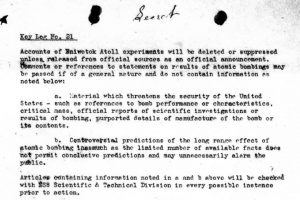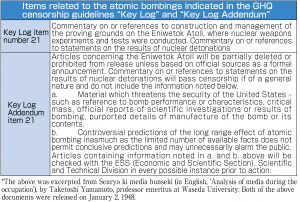Striving to fill voids in Hiroshima, Chugoku Shimbun and the press code — Surveillance of articles with A–bombing content, Part 3: Guidelines for censorship
Sep. 22, 2023
Unnerved by media coverage of A-bombing, GHQ added criteria to guidelines for censorship
During the initial period of censorship imposed by the General Headquarters of the Allied Powers (GHQ), the Chugoku Shimbun carried a total of 71 articles with A–bombing content that evaded censorship. Why were the articles left uncensored? The key to solving this mystery was found in guideline documents used by media censors at that time.
Key Log documents
There were two such documents — one known as the “Key Log,” and the other its supplementary “Key Log Addendum.” The press code’s 10 items, including the provision that “There shall be no destructive criticism of the Allied Occupation,” were somewhat abstract. The Key Log was used as a foundational manual for the censorship system, and the Key Log Addendum served as a detailed explanation of the finer points. The two documents underwent modification when necessary. The censors needed to be familiar with both documents.
Taketoshi Yamamoto, professor emeritus at Waseda University and a specialist in the area of media censorship carried out during the period of Japan’s occupation, introduced in one of his publications both of the documents, which were first released on January 2, 1948. Each of the documents was made up of 25 items.
The 21st item in the Key Log involved the issue of the atomic bombings, referring to commentary on or references to the construction and management of the proving grounds at the Eniwetok Atoll, on which experiments and tests of nuclear weapons were carried out, as well as commentary on and references to statements on the results of nuclear detonations.
The Key Log Addendum’s item number 21 provided more detail about what was prohibited for reporting by the media. The document demanded that any information on the nuclear tests conducted on the Eniwetok Atoll of the Marshall Islands in the central Pacific region be limited to that derived from official announcements. It prohibited news touching on the nature of the dropping of the atomic bombs, criticism from the public, and the methods of manufacture of the bombs, among other information. The document also instructed avoidance of reporting on the long-term effects of the atomic bombings, based on the idea that any conclusive predictions concerning the effects would be difficult.
When handling such articles, the censors were asked to not make their own judgments but to seek the opinions of the GHQ’s Economic and Scientific Section (ESS), Scientific and Technical Division.
When did a specific censorship policy for articles with A-bombing content first appear in the Key Log?
First appearance thought to be January 1948
The results of our newspaper’s investigation into GHQ documents turned up a “Tentative Key Log” document, dated December 31, 1947. To the document had been added information on the issue of avoiding media coverage concerning the long-term effects of the atomic bombings. Two days later, the draft document was approved as the official version. GHQ censorship apparently did not take time off for the New Year’s holiday.
Also discovered were documents that pre-dated the release of the official version — a Key Log version dated May 15, 1947, and another dated September 15, 1947. However, neither of the documents contained any mention of the atomic bombings. With that, the Key Log document dated January 2, 1948, is presumed to be the first to touch on A-bombing content.
At that time, it was clearly the case that the GHQ was unnerved about the media’s reporting of the long-term effects of the atomic bombings.
By then, two years had passed since the bombings. It was a time when newspapers had begun to run articles reporting on specific symptoms experienced by the A-bomb survivors, such as leukemia, suspected of having been caused by the atomic bombings. The GHQ appears to have concluded internally that new criteria for censorship were necessary. What articles specifically triggered such a response? Articles appearing in the Chugoku Shimbun and national newspapers were analyzed but no conclusive evidence was found.
The censorship of articles with A-bombing content grew more severe in line with revisions made to the Key Log, a situation that also affected the Chugoku Shimbun. Of the 327 A-bombing articles published by the Chugoku Shimbun in 1948, 275 were subject to censorship (censorship rate: 84.1 percent). That significantly exceeded the censorship rate for the articles published in 1946 (55.0 percent).
(Originally published on September 22, 2023)









